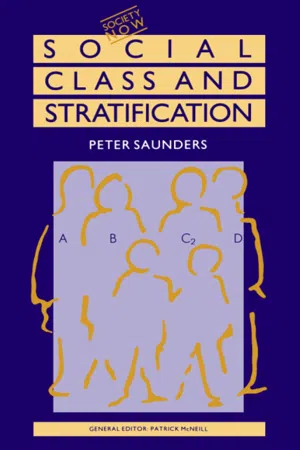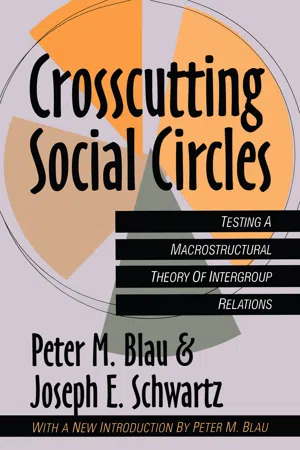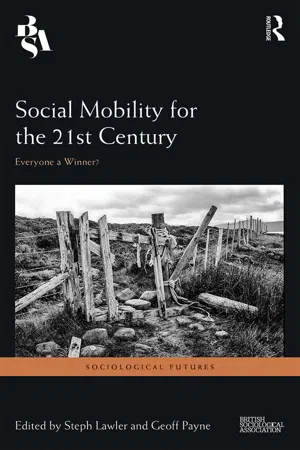Social Sciences
Social Mobility
Social mobility refers to the ability of individuals or groups to move within or between social strata or classes in a society. It encompasses upward or downward movement in terms of wealth, education, occupation, or social status. The concept is central to understanding the dynamics of inequality and opportunity within a society.
Written by Perlego with AI-assistance
Related key terms
6 Key excerpts on "Social Mobility"
- eBook - ePub
The Sociology of Education
An Introduction
- Ivor Morrish(Author)
- 2019(Publication Date)
- Routledge(Publisher)
Chapter 8 Social Mobility and EducationA. The Meaning of Social Mobility
Social Mobility is basically the movement of individuals, or groups of individuals, from one social position to another; such a movement may be up or down between the classes in any social hierarchy or stratification (that is, vertical mobility), or it may occur within a particular social class (that is, horizontal mobility). In his discussion of this topic, J. A. Schumpeter (1) regarded the abilities of persons as the key to upward mobility, although he provided a variety of reasons why both individuals and families might rise or fall within a particular class, or might move from one class to another. Without considering all the details of his arguments, we may note his suggestion that the history of mobility has elicited the following causes, some of which are more important factors in mobility than others.Thus, for example, a man whose status and wealth are really invested in his possession of land may find that his property has suddenly, or over a period of years; appreciated or depreciated. This will mean that, although he still has the status of a landowner, his style of living may be considerably improved or may suffer. Social Mobility may also occur through the sort of power which accrues to certain families, not merely via nepotism but because of the fact that they are in a favourable position for self-advancement. Skill and success in war have also been the cause of advancement of certain notable individuals, including many others who have suddenly discovered that the services were, in fact, their particular métier and their ideal milieu - eBook - ePub
Education, Inequality and Social Class
Expansion and Stratification in Educational Opportunity
- Ron Thompson(Author)
- 2019(Publication Date)
- Routledge(Publisher)
Reducing educational inequality may have a part to play in this, but the interactions involved are complex and difficult to predict. It is well known that the greater class mobility in Britain between the late 1940s and the early 1970s was largely due to the first of these conditions being met (Goldthorpe 1980). The second condition would require a reduction in the effectiveness of class strategies aimed at maintaining the position of more advantaged groups; as we have seen in previous chapters, this would imply a move away from policies such as marketization and diversification which are associated with greater inequality – a move unlikely to occur in countries dominated by neo-liberal approaches to managing their economies and educational systems. Patterns of intergenerational Social Mobility Concerns in the United Kingdom over whether Social Mobility has stalled are echoed in the United States and in many other countries (OECD 2010; Hout 2015). As is often the case, such debates hinge around questions of definition and measurement: what do we mean precisely by Social Mobility, and how can we measure it? In his pioneering study, Pitirim Sorokin (1927, p. 133) defines Social Mobility quite generally as the transition of individuals from one social position to another within a society stratified by attributes such as class, status or income. Transitions between positions at similar levels are examples of horizontal mobility, whilst vertical mobility (upwards or downwards) describes transitions between positions on different social levels. As with educational inequality, choices concerning how stratification is measured depend partly on the disciplinary location of researchers: for economists, social position is most often conceptualized in terms of a continuous variable, such as income, whereas for sociologists, categorical variables, such as social class or socio-economic status, are more likely to be of interest - eBook - ePub
- Peter Saunders(Author)
- 2006(Publication Date)
- Routledge(Publisher)
The third point is that movement across a short range of positions in the social hierarchy is more common than movement across a wide range. This is not surprising, of course, for we should expect individuals to find it easier to improve their position marginally than to improve it dramatically.Measuring Social MobilityThis third point raises a fundamental problem in the study of Social Mobility, however, for it is not always clear that marginal changes in position really constitute Social Mobility at all. For example, many studies have shown considerable movement across the boundary between manual and non-manual occupations. This is especially marked in the case of women, for many typically female occupations are classified as routine white collar jobs (secretaries, clerks, personal service workers, and so on). But if the daughter of a skilled fitter leaves school with a handful of mediocre GCSE certificates and gets employment as a filing clerk, does this really represent upward movement? Her wages may never reach the earnings of her father, her responsibility and authority is minimal, and her status is fairly low despite the fact that she does her work in skirt and blouse rather than overalls.It follows from this that any analysis of Social Mobility must remain alert to three related issues. First, we must not allow ourselves to be misled by statistics showing large-scale movements across very narrow ranges, for in many cases, such changes may be virtually insignificant as regards people’s life chances, life styles and self-conceptions. Second, we must constantly bear in mind that social stratification is multidimensional, and that a move upwards on one dimension (an improvement in social status, for example) need not imply a simultaneous move upwards on others (an increase in authority or a rise in income, for example). And third, we need to bear in mind that people’s lives often follow very ‘lumpy’ trajectories – our hypothetical female filing clerk, for example, may leave work after a few years, have children, and move back into a very different occupation in middle age. Comparison of people’s positions at one point in time may therefore ignore important changes which occur in other periods of their lives. - eBook - ePub
Class Stratification
Comparative Perspectives
- Richard Breen, David B. Rottman(Authors)
- 2014(Publication Date)
- Routledge(Publisher)
CHAPTER 5Social MobilityIntroduction
Neither the position of families nor individuals within the class structure nor that structure itself, remain constant over time. Individuals and families change their class position and the class structure itself evolves, as some occupations decline and others become more numerous. Both these sorts of change have been intensively studied by sociologists and other social scientists. Examining the development of a class structure over time involves adopting a historical perspective, as in the work of Przeworski et al. (1980) or Wright and Martin (1987). The extent and the way in which families move through the class structure – between positions in it, in other words – is the subject matter of the study of Social Mobility. Social Mobility has long been a central topic of sociological inquiry, and has been particularly actively pursued over the past 25 years. In this chapter our aim is to explain what the study of Social Mobility is, to give a brief explanation of the methods used in Social Mobility analysis, and to summarize the main results of recent research. Before we begin, however, we need first to set the scene by saying something about the temporal dimension of social class.The temporal dimension of social class
There are a number of ways in which the temporal dimension of social class might be of relevance to us. We have already mentioned the phenomenon of people or families moving from one class to another: this is called Social Mobility, and examples of this are all around us. But there are other aspects to the temporal dimension of social class, of which we can identify three.First, the relative sizes of social classes can change over time. We see examples of this during the twentieth century in Europe, where the class structures of many societies have changed markedly. Among men, agriculture and agricultural occupations have declined in significance, as has unskilled manual work, while white-collar jobs and skilled manual jobs have become more numerous. This kind of change is usually called ‘structural’ change – in other words, a change in the class structure. - eBook - ePub
Crosscutting Social Circles
Testing a Macrostructural Theory of Intergroup Relations
- Peter M. Blau, Joseph E. Schwartz(Authors)
- 2018(Publication Date)
- Routledge(Publisher)
CHAPTER 3Social Mobility
Two important social processes that are closely connected with a social structure and its dynamics are processes of association between people and processes of mobility of people. Social associations are channels of communications, while Social Mobility entails channels of movements of people from one social position to another. The processes of social association and mobility influence each other directly, and mobility also exerts an indirect influence on rates of associations between groups by usually altering their relative size.Social Mobility typically results in structural change, that is, in changes in population distributions, whatever the ultimate exogenous conditions that created the demands for the redistribution of people. Whether technological or economic or political developments are the basic cause of the required redistribution, it is the movement of people that brings the redistribution about—their occupational or economic or educational or industrial mobility. Although differences in fertility among groups or strata alter population distributions even in the absence of Social Mobility, the very population changes so produced generally precipitate mobility as a needed adjustment to economic conditions. An illustration is the high birth rate of farmers which engenders pressures to move out of farming into other lines of work.The next three chapters deal with the dynamics of Social Mobility and structural change. The relationships of mobility with social associations and with changes in structural differentiation in any one dimension are examined in this chapter. The intersection and consolidation of multiple dimensions of social differences and how mobility is related to change in these structural conditions are analyzed in the next chapter. The processes of status attainment within the metropolitan structure that help shape that structure are the topic of Chapter 5 - eBook - ePub
Social Mobility for the 21st Century
Everyone a Winner?
- Steph Lawler, Geoff Payne(Authors)
- 2017(Publication Date)
- Routledge(Publisher)
A second early conception, equally under-developed in modern analysis, was that of Sorokin (1927), who although not using our contemporary terminology proposed that mobility should be seen as taking place in a highly dynamic, multi-dimensional social space. People became mobile through marriage, political struggle, schooling, or migration, as well as through employment. He concluded that these dimensions of the social space had two main axes: a horizontal geographical movement, and a vertical class mobility.This more rounded view – the later edition of his book was re-titled Social and Cultural Mobility (1941) – had little influence in Britain after the 1949 LSE study (Glass 1954). The geographical dimension of mobility was neglected, both in the form of local labour market availability of origins and destinations, and in the disorienting effects of leaving one local culture and entering another when people moved home to find paid employment elsewhere. One consequence has been that the burgeoning field of migration studies has yet to make an impact on mobility analysis, and vice versa.Ironically, three-quarters of the LSE ‘study’ consisted of chapters discussing wider mobility issues: secondary education policy (three by Floud, Himmelweit, and Martin), mobility by marriage (three by Berent, Mukherjee, and Hall), voluntary organisations (two by Bottomore and Chambers), recruitment to the professions (Kelsall), mobility over three generations (Mukherjee), and subjective aspects of mobility (Martin). However, apart from the educational dimension, these topics were overshadowed by the sections reporting mobility in terms of status, class, and elites. Other studies in this period, which offered different estimates of mobility rates, made little impact (e.g. Ginsberg 1929; Saunders 1931; Benjamin 1958; Nalson 1968).Sorokin’s conception of alternative routes to upward mobility and new identities had more influence in North American sociology, largely in the 1950s. In the US, several researchers pointed to unconventional forms of achievement, including the personal success stories of those at the margins of ‘decent society’: gangsters and sex-workers; illegal money-lenders, bookies, and gamblers; drug dealers; minority ethnic politicians; night-club entertainers; and bootleggers during Prohibition (some of whom, like President Kennedy’s father, as alleged by Brooklyn mafia boss Frank Costello, went on to convert their illegal capital into respectable family business and political capital): see Bell (1953); Cayton and Drake (1954); and O’Kane (1992).
Learn about this page
Index pages curate the most relevant extracts from our library of academic textbooks. They’ve been created using an in-house natural language model (NLM), each adding context and meaning to key research topics.





